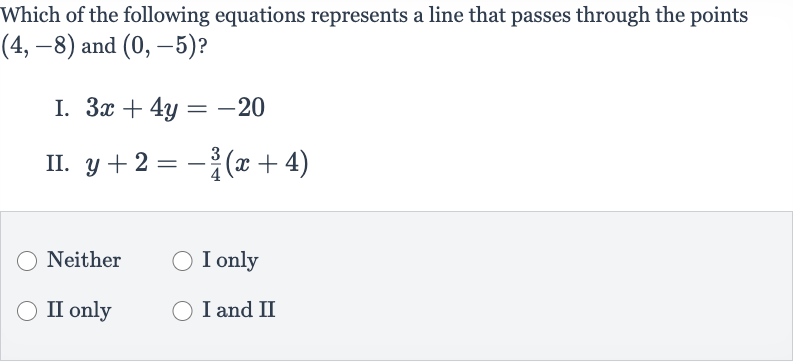Full solution
Q. Which of the following equations represents a line that passes through the points and ?I. II. NeitherI onlyII onlyI and II
- Find Slope: Find the slope of the line passing through the points and . The slope is calculated using the formula .
- Write Point-Slope Equation: Use the slope and one of the points to write the equation of the line in point-slope form.Let's use the point and the slope .The point-slope form is .
- Convert to Slope-Intercept: Convert the point-slope form to slope-intercept form to find the y-intercept .
- Check Equation I: Check if equation I is the same line by rearranging it into slope-intercept form.
- Check Equation II: Compare the slope and y-intercept of equation I with the line's slope and y-intercept from Step .The slope of equation I is , which matches the slope we found.The y-intercept of equation I is , which does not match the y-intercept we found ().Therefore, equation I does not represent the line passing through the points and .
- Check Equation II: Compare the slope and -intercept of equation I with the line's slope and -intercept from Step .The slope of equation I is , which matches the slope we found.The -intercept of equation I is , which does not match the -intercept we found ().Therefore, equation I does not represent the line passing through the points and .Check if equation II () is the same line by rearranging it into slope-intercept form.
- Check Equation II: Compare the slope and y-intercept of equation I with the line's slope and y-intercept from Step .The slope of equation I is , which matches the slope we found.The y-intercept of equation I is , which does not match the y-intercept we found ().Therefore, equation I does not represent the line passing through the points and .Check if equation II () is the same line by rearranging it into slope-intercept form.Compare the slope and y-intercept of equation II with the line's slope and y-intercept from Step .The slope of equation II is , which matches the slope we found.The y-intercept of equation II is , which does not match the y-intercept we found ().Therefore, equation II does not represent the line passing through the points and .
More problems from Write a quadratic function from its x-intercepts and another point
QuestionGet tutor help
QuestionGet tutor help
QuestionGet tutor help
QuestionGet tutor help
QuestionGet tutor help
QuestionGet tutor help
QuestionGet tutor help
QuestionGet tutor help

